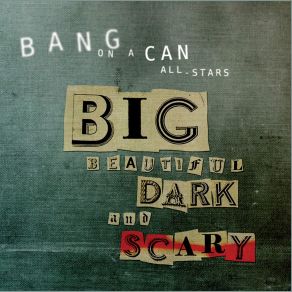Big Beautiful Dark and Scary
Download links and information about Big Beautiful Dark and Scary by Bang On A Can. This album was released in 2012 and it belongs to genres. It contains 19 tracks with total duration of 01:35:44 minutes.

|
|
|---|---|
| Artist: | Bang On A Can |
| Release date: | 2012 |
| Genre: | |
| Tracks: | 19 |
| Duration: | 01:35:44 |
| Buy it NOW at: | |
| Buy on iTunes $11.99 | |
| Buy on Amazon $17.59 | |
Tracks
[Edit]| No. | Title | Length |
|---|---|---|
| 1. | Big Beautiful Dark and Scary | 8:44 |
| 2. | Sunray | 10:11 |
| 3. | For Madeline | 7:52 |
| 4. | Music from Shadowbang: Angkat | 3:00 |
| 5. | Music from Shadowbang: Ocean | 4:08 |
| 6. | Music from Shadowbang: Meditasi - Head | 6:01 |
| 7. | Instructional Video | 1:49 |
| 8. | Matt Damon | 4:18 |
| 9. | Breakfast at J&M | 1:51 |
| 10. | Four Player Piano Studies: Study No. 2a (Arr. Evan Ziporyn) | 3:57 |
| 11. | Four Player Piano Studies: Study No. 3a (Arr. Evan Ziporyn) | 4:38 |
| 12. | Four Player Piano Studies: Study No. 3c (Arr. Evan Ziporyn) | 3:22 |
| 13. | Four Player Piano Studies: Study No. 11 (Arr. Evan Ziporyn) | 3:29 |
| 14. | Life: I. Wind | 4:59 |
| 15. | Life: II. Couple | 4:31 |
| 16. | Life: III. In the Distance | 1:26 |
| 17. | Life: IV. Light | 2:05 |
| 18. | Ridgeway | 12:55 |
| 19. | Closing (Live) (featuring Philip Glass) | 6:28 |
Details
[Edit]This release marks the 25th anniversary of the New York mostly percussion ensemble Bang On A Can (the All-Stars mentioned here include collaborators like clarinetist-composer Evan Ziporyn). The group's lasting popularity and influence are further attested to by the more than 5,000 memories the band received after offering free downloads from the album to anyone who sent them one. This double-album set might serve the curious as an introduction to Bang On A Can, which fearlessly proclaimed the connectedness of musical traditions generally thought to be separate when it came on the scene in the late 1980s. Ziporyn's Music from Shadow Bang reflects the composer's study of Indonesian percussion traditions. David Longstreth's cheekily titled Instructional Video, Matt Damon, and Breakfast at J&M reflect the interface between Bang On A Can and the world of alternative rock, while kinetic pieces by Julia Wolfe, David Lang, and Michael Gordon hark back to the group's "downtown" origins. A piece by Louis Andriessen shows the group's ability to take on a more severe modernist idiom, while Conlon Nancarrow's Four Player Piano Studies, arranged by Ziporyn, put a new, non-mechanistic spin on those works. All these pieces coexist cheerfully, and the sheer range of the group's expertise and enthusiasms ensures the music is anything but boring. A good place to start with this group, which seems likely to notch a second quarter century of performing and recording.